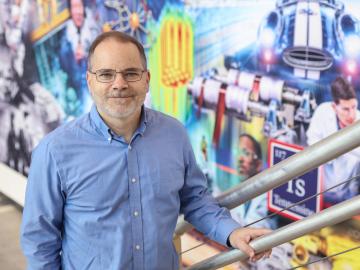Filter News
Area of Research
News Type
Date
News Topics
- 3-D Printing/Advanced Manufacturing (3)
- Advanced Reactors (1)
- Artificial Intelligence (8)
- Big Data (6)
- Bioenergy (4)
- Biology (4)
- Biomedical (2)
- Biotechnology (3)
- Buildings (6)
- Chemical Sciences (8)
- Clean Water (3)
- Climate Change (11)
- Composites (2)
- Computer Science (7)
- Critical Materials (3)
- Decarbonization (8)
- Energy Storage (6)
- Environment (10)
- Exascale Computing (1)
- Frontier (1)
- Fusion (2)
- Grid (1)
- High-Performance Computing (6)
- Isotopes (3)
- ITER (1)
- Machine Learning (4)
- Materials (5)
- Materials Science (3)
- Mathematics (1)
- National Security (4)
- Net Zero (1)
- Neutron Science (2)
- Nuclear Energy (1)
- Partnerships (2)
- Physics (1)
- Polymers (3)
- Quantum Computing (1)
- Security (1)
- Simulation (3)
- Statistics (2)
- Sustainable Energy (5)
- Transportation (4)
Media Contacts

Scientists at the Department of Energy’s Oak Ridge National Laboratory have developed lubricant additives that protect both water turbine equipment and the surrounding environment.

Groundwater withdrawals are expected to peak in about one-third of the world’s basins by 2050, potentially triggering significant trade and agriculture shifts, a new analysis finds.

Cheekatamarla is a researcher in the Multifunctional Equipment Integration group with previous experience in product deployment. He is researching alternative energy sources such as hydrogen for cookstoves and his research supports the decarbonization of building technologies.

Keith Kline, Rigoberto Advincula and Takeshi Egami have been elected fellows of the American Association for the Advancement of Science, the world’s largest general scientific society and publisher of the Science family of journals.

Inspection technology developed by Oak Ridge National Laboratory will help deliver plasma heating to the ITER international fusion facility.
Chemists at ORNL have invented a more efficient way to extract lithium from waste liquids leached from mining sites, oil fields and used batteries. They demonstrated that a common mineral can adsorb at least five times more lithium than can be collected using previously developed adsorbent materials.

An international team using neutrons set the first benchmark (one nanosecond) for a polymer-electrolyte and lithium-salt mixture. Findings could produce safer, more powerful lithium batteries.

David Sholl has been named the executive director of the University of Tennessee-Oak Ridge Innovation Institute (UT-ORII) and vice provost of University of Tennessee, Knoxville, after serving as the institute’s interim leader since June 2023.

A first-ever dataset bridging molecular information about the poplar tree microbiome to ecosystem-level processes has been released by a team of DOE scientists led by ORNL. The project aims to inform research regarding how natural systems function, their vulnerability to a changing climate and ultimately how plants might be engineered for better performance as sources of bioenergy and natural carbon storage.

Jens Dilling has been named associate laboratory director for the Neutron Sciences Directorate at the Department of Energy’s Oak Ridge National Laboratory, effective April 1.




